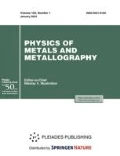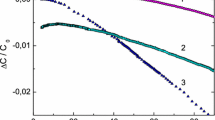Abstract
The concentration dependence of the Curie constant in the magnetic susceptibility of impurities of transition elements in a nonmagnetic matrix is considered for the case where the energy level of an impurity electron falls into the conduction band and hybridized states arise. As a result of an analysis of the new experimental data on the magnetic susceptibility of the iron impurity in crystals of mercury selenide, a substantiation of the earlier proposed simple formula that describes the linear dependence of the Curie constant on the concentration of impurities with allowance for the hybridization of states is given. The application of this formula to the description of the temperature dependence of the magnetic susceptibility of the cobalt impurities allowed us, on the basis of the formulated ideas about the arrangement of the energy levels of d electrons and of the available data on the Hall concentration of electrons, to find the effective spin of the hybridized electronic states at the impurity cobalt and the resonance value of the concentration of donor electrons.
Similar content being viewed by others
References
G. A. Alshanskii, V. L. Konstantinov, A. V. Korolyov, et al., “Magnetic Properties of the Fe Impurity Spin System in Gapless Semiconductor HgSe,” Phys. Met. Metallogr. 93(Suppl. 1), S142–S144 (2002).
V. I. Okulov, G. A. Al’shanskii, V. L. Konstantinov, et al., “Magnetic Susceptibility of Resonance Donor Impurities of Transition Elements in Semiconductors,” Fiz. Nizk. Temp. 30(5), 558–562 (2004) [Low-Temp. Phys. 30 (5), 417–420 (2004)].
V. I. Okulov, “On the Theory of the Effects of Resonance Scattering of Conduction Electrons by Donor Impurities,” Fiz. Met. Metalloved. 100(2), 23–29 (2005) [Phys. Met. Metallogr. 100 (2), 116–122 (2005)].
V. I. Okulov, A. V. Korolev, A. T. Lonchakov, et al., “Experimental Study of Manifestation of Resonance Scattering of Conduction Electrons on Transition Element Impurities in Mercury Selenide,” Fiz. Nizk. Temp. 31(10), 1143–1152 (2005) [Low-Temperature Physics 31 (10), 872–879 (2005)].
V. I. Okulov, T. E. Govorkova, V. V. Gudkov, et al., “Low-Temperature Effects of Resonance Electronic States at Transition Element Impurities in the Kinetic, Magnetic, and Acoustic Properties of Semiconductors,” Fiz. Nizk. Temp. 33(2–3), 282–290 (2007) [Low-Temp. Phys. 33 (2), 207–213 (2004)].
Author information
Authors and Affiliations
Additional information
Original Russian Text © V.I. Okulov, G.A. Al’shanskii, T.E. Govorkova, V.L. Konstantinov, A.V. Korolev, E.A. Pamyatnykh, S.Yu. Paranchich, 2009, published in Fizika Metallov i Metallovedenie, 2009, Vol. 108, No. 2, pp. 124–127.
Rights and permissions
About this article
Cite this article
Okulov, V.I., Al’shanskii, G.A., Govorkova, T.E. et al. Determination of effective magnetic moments of the hybridized electronic states of impurities from the concentration dependence of the Curie constant. Phys. Metals Metallogr. 108, 116–119 (2009). https://doi.org/10.1134/S0031918X0908002X
Received:
Accepted:
Published:
Issue Date:
DOI: https://doi.org/10.1134/S0031918X0908002X



